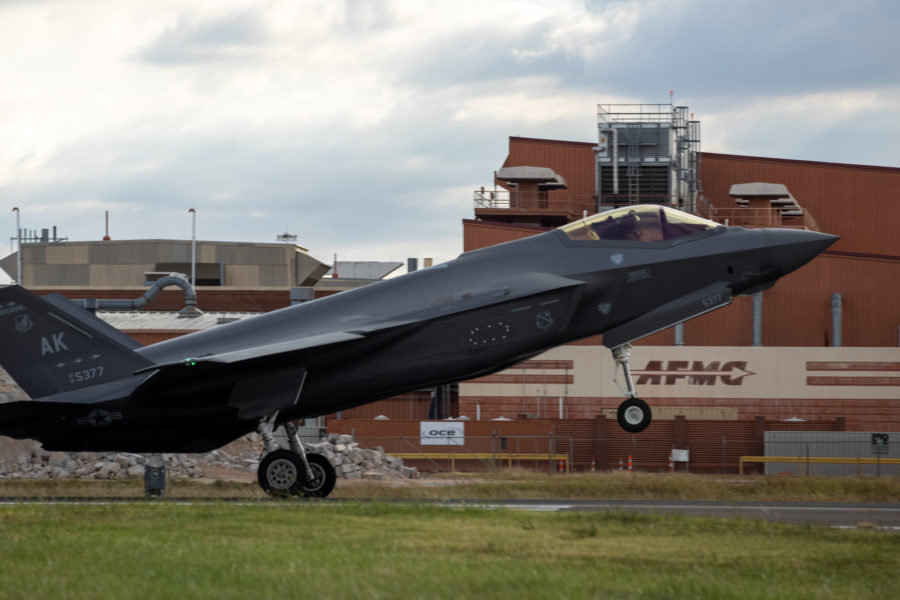Pratt & Whitney believes it has a fix in hand for the engine problem that may have contributed to an F-35B crash in December, and deliveries of all F-35 fighters, on hold since Dec. 27, 2022, could resume by March, according to the contractor.
“We have developed a near-term remedy that allows the fleet to fly safely, and we expect that F135 engine deliveries could resume before the end of the month,” said Jen Latka, vice president of Pratt & Whitney for the F135 engine, which powers the F-35 fighter.
Latka did not elaborate to Air & Space Forces Magazine on what the fix is, except to say that it addresses “a rare systems phenomenon involving harmonic resonance.”
The Dec. 14 crash that led to the halt in deliveries occurred during an F-35B acceptance flight at Lockheed Martin’s Fort Worth, Texas, facility—the aircraft suddenly pitched forward during a vertical descent and struck the runway. The pilot ejected at zero altitude and survived the escape with light injury.
The crash sparked an investigation, led by Naval Air Systems Command, which in turn led to all deliveries of F135 engines and F-35s being suspended.
A cracked fuel tube found in the wreck, suspected in the early days of the investigation, has turned out not to be a systemic problem, Latka said.
“After thorough review, we can confidently say there were no quality issues with the fuel tube that fractured,” she said.
“We are working closely” the F-35 Joint Program Office, Naval Air Systems Command and the Air Force Life Cycle Management Center “on all aspects of the ongoing investigation, including root cause determination and corrective action development,” Latka said. “Safety for the warfighter is and will continue to be our number one priority.” She noted that the F135 has accumulated 600,000 flight hours, and this experience along with “everything we’ve learned over the last 20 years” will be applied to “continue to mature and modernize the F135.”
A spokeswoman for NAVAIR could not offer an estimate of when the inquiry will be concluded. She offered no comment on whether any inspections or technical orders have been ordered as a result of a safety probe conducted in the wake of the accident.
The F-35 JPO referred queries about the engine situation to Pratt & Whitney.
A Lockheed Martin spokeswoman said the contractor has finished building—and is storing—17 F-35s since the halt in deliveries was ordered at the end of December. Production of the fighters has continued at a normal pace since then.
Several flight tests are required of each aircraft in order to complete the DD250 process, which is the handover protocol of a formal aircraft delivery. The Lockheed spokeswoman could not offer an estimate of how long it would take to complete those flight tests for the 17 aircraft.
Roughly a dozen of the 17 F-35s currently in storage were headed for Air Force duty, a service spokeswoman told Air & Space Forces Magazine. The aircraft were destined for Lakenheath Air Base, U.K.; Nellis Air Force Base, Nev.; Luke Air Force Base, Ariz.; and Hill Air Force Base, Utah, she said.
While there have been “no operational impacts” as a result of the F-35 deliveries hiatus, the Air Force spokeswoman said, she noted a problem with “the F-35 main fuel throttle valve has only impacted production aircraft and a very small number of fielded F-35s with low-time engines.”
The Air Force is “working with the [JPO], Department of the Navy, partners, Lockheed Martin and Pratt & Whitney toward a resolution to resume engine and aircraft deliveries as soon as possible,” she added.
Pratt has been lobbying the Air Force to go with its F135 Engine Core Upgrade (ECU) to provide the additional power and cooling required for the Block 4 version of the F-35.
The Air Force is also considering upgrading to one of the Adaptive Engine Transition Program (AETP) engines developed by Pratt and GE Aerospace. The two engines—GE’s XA-100 and Pratt’s XA-101—were developed as potential F-35 engine upgrades over a 12-year period. Both provide about a 30 percent increase in fuel efficiency, as well as improved thrust and cooling, thanks to a novel bypass air feature.
However, the JPO has warned the Air Force that it would have to bear the costs for the development of an AETP engine alone, as partners in the program, in the interest of commonality, have to “pay to be different.”
Pratt would prefer the Air Force go with the F135 ECU—even though Pratt has an AETP engine to offer—as such a choice would cement its monopoly as the sole provider of F-35 engines. The AETP option would potentially bring in GE as another source.
Air Force Secretary Frank Kendall has discussed engine development cost-sharing with Navy Secretary Carlos Del Toro, but no joint effort has been announced. While GE says its AETP can be adapted to fit any of the three F-35 variants, Pratt has said its version can’t be made to work with the F-35B, which employs a rotating rear nozzle and a vertically-mounted lift fan to achieve vertical takeoffs and landings.
USAF officials have said the F-35 engine question will likely be answered in the fiscal year 2024 President’s Budget, now expected to be released in early March.

